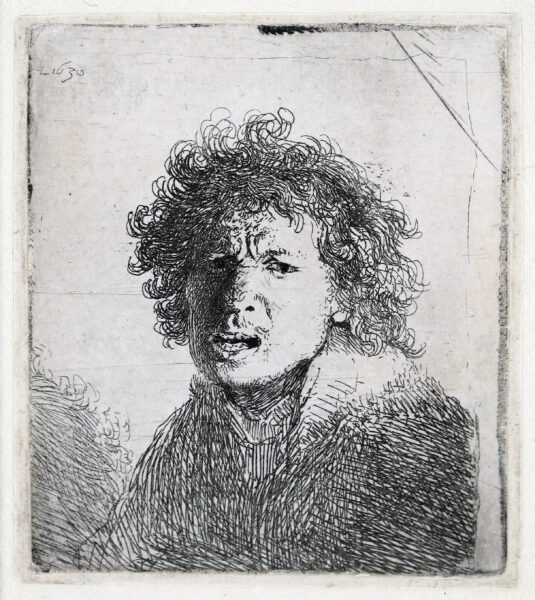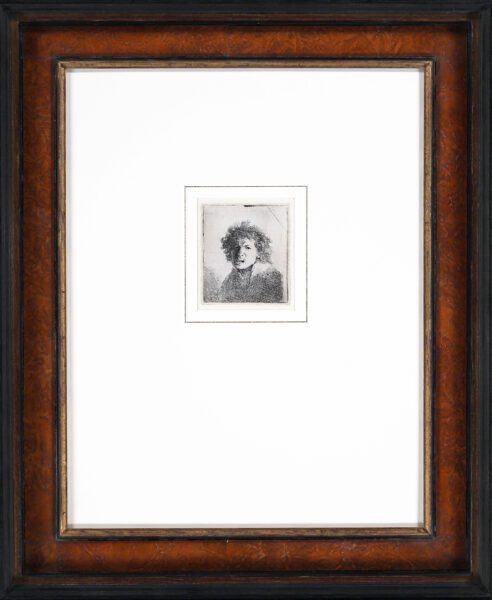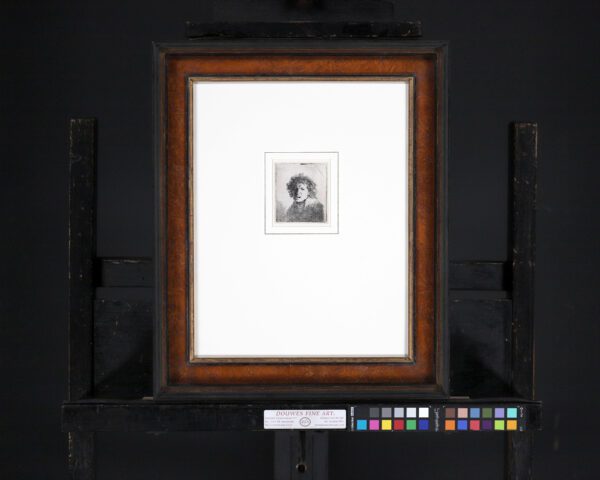“Self-Portrait open mouthed, as if shouting: bust”, 1630
etching on laid paper: 7,0 x 5,9 cm
signed in monogram and dated upper left: RHL 1630
"*" indicates required fields
REMBRANDT HARMENSZ. van RIJN
(Leiden 1606-1669 Amsterdam)
“Self-Portrait open mouthed, as if shouting: bust”, 1630
etching on laid paper: 7,0 x 5,9 cm
signed in monogram and dated upper left: RHL 1630
Bartsch 13; Hind 31;
The New Hollstein Dutch no. 67: Second state (of III)
Plate not in existence – with Nowell-Usticke (1967):
RR – a very scarce portrait
Provenance
- Collection A.J. Godby (Lugt 1119B)
- en D. Colnaghi;
- Kunsthandel Th. Laurentius,1980;
- Private collection, The Netherlands
- By descent to the current owners
Notes
This intriguing self-portrait is one of the tronies, small facial sketches, which Rembrandt created using himself and others as models around 1630. It is very clearly a study in how to convey a certain facial expression or emotional state, in this case anguish or fury. As Erik Hinterding observed, the harsh lateral light accentuates his furrowed brow and open mouth (see: Hinterding, 2008, no. 7, p. 50-51). The wild hair and forward-thrust head and chin further heighten the irritation, even aggression, the figure projects.
This print presumably slightly precedes Rembrandt’s more elaborate etching of the Beggar seated on a Bank of the same year, in which the figure has the same expression. Although the face of the beggar is not directly copied from the present print, the artist clearly referred back to it – which explains why the beggar is usually seen as a self-portrait in disguise.
During his lifetime, Rembrandt’s extraordinary skills as a printmaker were the main source of his international fame. Unlike his oil paintings, prints travelled light and were relatively cheap. For this reason, they soon became very popular with collectors not only within but also beyond the borders of the Netherlands.
Rembrandt’s etchings are remarkable for their high number of self-portraits (over 30 out of about 290). These are particularly collectible, perhaps due to the smaller number of states as well as the artist’s compelling and powerful presence. Unlike his stately religious scenes, or regal, posed portraits of others, which exhibit his careful and calculating brilliance as an etcher, Rembrandt’s self-portraits reveal him as an artist and a man. In them he assumes the role of the experimenting artist, approaching the most difficult of subjects – himself. These self-portraits are often described as ethereal and wistful for their notable contrasting areas of high and low etched space.
Literature
Bartsch 13; The New Hollstein Dutch no. 67: Second state (of III)
Plate not in existence – with Nowell-Usticke (1967):
RR – a very scarce portrait
Provenance
- Collection A.J. Godby (Lugt 1119B)
- en D. Colnaghi;
- Kunsthandel Th. Laurentius,1980;
- Private collection, The Netherlands
- By descent to the current owners





